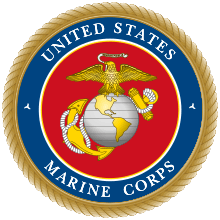VMF-441
Marine Fighting Squadron 441 (VMF-441) was a fighter squadron of the Marine Forces Reserve during the Cold War. They were originally activated during World War II and fought during the Battle of Okinawa. Nicknamed "The Blackjacks", they were credited with 49 planes shot during the course of the war.[1]
| Marine Fighting Squadron 441 | |
|---|---|
VMF-441's insignia | |
| Active |
|
| Country | United States |
| Allegiance | United States of America |
| Branch | United States Marine Corps |
| Type | Fighter squadron |
| Role | Air interdiction Close air support |
| Part of | Inactive |
| Nickname(s) | "Blackjacks" |
| Engagements | World War II * Gilbert and Marshall Islands campaign * Battle of Okinawa |
| Aircraft flown | |
| Fighter | SNJ Texan F4F-4 Wildcat F4U-1/FG-1 Corsairs |
Following the surrender of Japan, the squadron was deactivated on July 11, 1946. They were reactivated in the Marine Forces Reserve and were based out of Naval Air Station Niagara Falls, New York.
History
Marine Fighting Squadron 441 (VMF-441) was activated on October 1, 1942, at Tutuila on American Samoa from elements of VMF-111 and flew the F4F Wildcat.[2][3] By the end of May 1943 the entire squadron had moved to Funafuti in the Ellice Islands and this was followed on September 28, 1943, by another move to Nanumea.[4] The squadron moved back to Tutuila in December 1943 where they transitioned to the F4U-1 Corsair.[3]
On January 1, 1944, VMF-441 joined Marine Aircraft Group 31 (MAG-31) on Roi-Namur. By March 1944 the squadron was again on the offensive conducting raids against Mili and Jaluit.[4]
During the Battle of Okinawa, VMF-441 landed at Yontan Airfield on April 7, 1945.[5] On April 16, 1945, four divisions of VMF-441 planes came to the rescue of the destroyer USS Laffey (DD-724) which had already been hit by five kamikazes. Their Corsairs attacked a flight of 25 Japanese planes and were credited with shooting down 15½ enemy planes, losing one of their own because he was flying so low that both he and the Japanese plane he was chasing clipped Laffey's superstructure.[6][7] The squadron was still on Okinawa when the Japanese surrendered in August 1945. Shortly thereafter, the squadron was alerted for occupation duty in mainland Japan as part of Marine Aircraft Group 31 (MAG-31). Maj Paul T. Johnston, then commanding officer of the squadron, piloted the first Marine plane to land in mainland Japan when his F4U Corsair touched down at Yokosuka. He was quickly followed by the other 21 planes in his squadron. The squadron remained in Japan until March 1946. During their time on Occupation Duty the squadron logged over 3000 flight hours. They returned to the United States in April 1946 and were deactivated at Marine Corps Air Station Miramar, California on July 11, 1946.[2]
An order of the Commandant of the Marine Corps on 10 September 1951, to take effect on 22 October 1951, directed the re-establishment of VMF-441 as part of the Marine Corps Reserve. The squadron based at Niagara Falls, New York until 28 February 1959 when it moved to NAS Willow Grove.
Unit awards
A unit citation or commendation is an award bestowed upon an organization for the action cited. Members of the unit who participated in said actions are allowed to wear on their uniforms the awarded unit citation. VMF-441 was presented with the following awards:
| Ribbon | Unit Award |
| Presidential Unit Citation | |
| Asiatic-Pacific Campaign Medal | |
| World War II Victory Medal | |
| National Defense Service Medal with one Bronze Star |
See also
- United States Marine Corps Aviation
- Organization of the United States Marine Corps
- List of active United States Marine Corps aircraft squadrons
- List of inactive United States Marine Corps aircraft squadrons
Notes
- "VMF-441". Fighting Squadrons of the USMC in WWII. www.acepilots.com. Retrieved 2007-12-19.
- Rottman USMC WWII OOB, p.444.
- Crowder USMC Aviation Squadron, p.148.
- Sherrod History of Marine Corps Aviation in WWII, p.470.
- DeChant Devilbirds, p. 225.
- AlexanderThe Final Campaign, p.30.
- DeChant Devilbirds, p. 226.
References
- Alexander, Joseph. The Final Campaign: Marines in the Victory on Okinawa. Washington D.C.: U.S. Marine Corps Historical Center.
- Crowder, Michael J. (2000). United States Marine Corps Aviation Squadron Lineage, Insignia & History – Volume One – The Fighter Squadrons. Paducah, KY: Turner Publishing Company. ISBN 1-56311-926-9.
- De Chant, John A. (1947). Devilbirds – The Story of United States Marine Aviation in World War II. New York: Harper & Brothers.
- Rottman, Gordon L. (2002). U.S. Marine Corps World War II Order of Battle – Ground and Air Units in the Pacific War, 1939–1945. Greenwood Press. ISBN 0-313-31906-5.
- Sherrod, Robert (1952). History of Marine Corps Aviation in World War II. Washington, D.C.: Combat Forces Press. OCLC 1261876.
